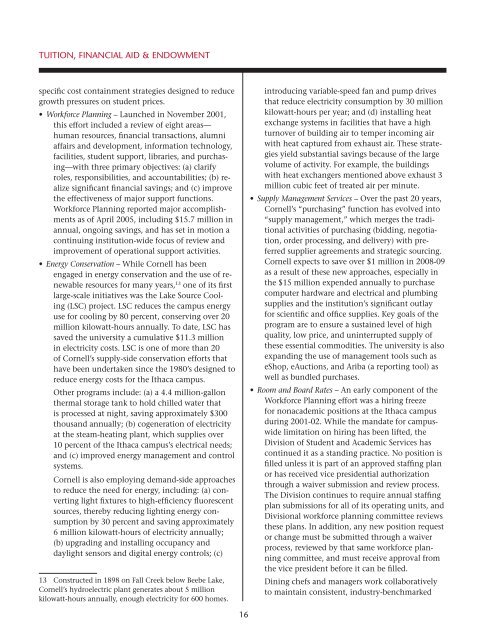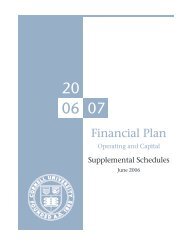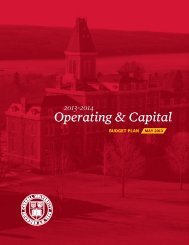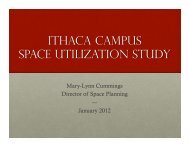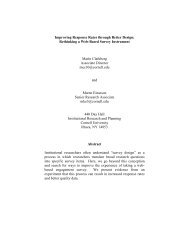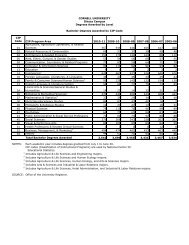Tuition, <strong>Financial</strong> Aid & Endowmentspecific cost containment strategies designed to reducegrowth pressures on student prices.• Workforce <strong>Plan</strong>ning – Launched in November 2001,this effort included a review <strong>of</strong> eight areas—human resources, financial transactions, alumniaffairs and development, information technology,facilities, student support, libraries, and purchasing—withthree primary objectives: (a) clarifyroles, responsibilities, and accountabilities; (b) realizesignificant financial savings; and (c) improvethe effectiveness <strong>of</strong> major support functions.Workforce <strong>Plan</strong>ning reported major accomplishmentsas <strong>of</strong> April 2005, including $15.7 million inannual, ongoing savings, and has set in motion acontinuing institution-wide focus <strong>of</strong> review andimprovement <strong>of</strong> operational support activities.• Energy Conservation – While <strong>Cornell</strong> has beenengaged in energy conservation and the use <strong>of</strong> renewableresources for many years, 13 one <strong>of</strong> its firstlarge-scale initiatives was the Lake Source Cooling(LSC) project. LSC reduces the campus energyuse for cooling by 80 percent, conserving over 20million kilowatt-hours annually. To date, LSC hassaved the university a cumulative $11.3 millionin electricity costs. LSC is one <strong>of</strong> more than 20<strong>of</strong> <strong>Cornell</strong>’s supply-side conservation efforts thathave been undertaken since the 1980’s designed toreduce energy costs for the Ithaca campus.Other programs include: (a) a 4.4 million-gallonthermal storage tank to hold chilled water thatis processed at night, saving approximately $300thousand annually; (b) cogeneration <strong>of</strong> electricityat the steam-heating plant, which supplies over10 percent <strong>of</strong> the Ithaca campus’s electrical needs;and (c) improved energy management and controlsystems.<strong>Cornell</strong> is also employing demand-side approachesto reduce the need for energy, including: (a) convertinglight fixtures to high-efficiency fluorescentsources, thereby reducing lighting energy consumptionby 30 percent and saving approximately6 million kilowatt-hours <strong>of</strong> electricity annually;(b) upgrading and installing occupancy anddaylight sensors and digital energy controls; (c)13 Constructed in 1898 on Fall Creek below Beebe Lake,<strong>Cornell</strong>’s hydroelectric plant generates about 5 millionkilowatt-hours annually, enough electricity for 600 homes.introducing variable-speed fan and pump drivesthat reduce electricity consumption by 30 millionkilowatt-hours per year; and (d) installing heatexchange systems in facilities that have a highturnover <strong>of</strong> building air to temper incoming airwith heat captured from exhaust air. These strategiesyield substantial savings because <strong>of</strong> the largevolume <strong>of</strong> activity. For example, the buildingswith heat exchangers mentioned above exhaust 3million cubic feet <strong>of</strong> treated air per minute.• Supply Management Services – Over the past 20 years,<strong>Cornell</strong>’s “purchasing” function has evolved into“supply management,” which merges the traditionalactivities <strong>of</strong> purchasing (bidding, negotiation,order processing, and delivery) with preferredsupplier agreements and strategic sourcing.<strong>Cornell</strong> expects to save over $1 million in 2008-09as a result <strong>of</strong> these new approaches, especially inthe $15 million expended annually to purchasecomputer hardware and electrical and plumbingsupplies and the institution’s significant outlayfor scientific and <strong>of</strong>fice supplies. Key goals <strong>of</strong> theprogram are to ensure a sustained level <strong>of</strong> highquality, low price, and uninterrupted supply <strong>of</strong>these essential commodities. The university is alsoexpanding the use <strong>of</strong> management tools such aseShop, eAuctions, and Ariba (a reporting tool) aswell as bundled purchases.• Room and Board Rates – An early component <strong>of</strong> theWorkforce <strong>Plan</strong>ning effort was a hiring freezefor nonacademic positions at the Ithaca campusduring 2001-02. While the mandate for campuswidelimitation on hiring has been lifted, the<strong>Division</strong> <strong>of</strong> Student and Academic Services hascontinued it as a standing practice. No position isfilled unless it is part <strong>of</strong> an approved staffing planor has received vice presidential authorizationthrough a waiver submission and review process.The <strong>Division</strong> continues to require annual staffingplan submissions for all <strong>of</strong> its operating units, and<strong>Division</strong>al workforce planning committee reviewsthese plans. In addition, any new position requestor change must be submitted through a waiverprocess, reviewed by that same workforce planningcommittee, and must receive approval fromthe vice president before it can be filled.Dining chefs and managers work collaborativelyto maintain consistent, industry-benchmarked16
Tuition, <strong>Financial</strong> Aid & Endowmentfood cost targets. They watch market fluctuationsin various food categories and plan menus tomaintain expected quality standards while controllingfood costs as a percentage <strong>of</strong> sales at targetlevels. Success in this objective, while providingwholesome and varied food <strong>of</strong>ferings, has beenvery challenging recently due to the significantimpact <strong>of</strong> fuel costs on food transportation.Both <strong>of</strong> these efforts are designed to limit thegrowth <strong>of</strong> costs that students ultimately pay forthrough room and board charges.• Cost Allocation Methodology – <strong>Cornell</strong> has recentlyrevised its cost allocation methodology (CAM),which is used internally to associate a little over$250 million <strong>of</strong> central administrative and supportcosts with college and operating unit revenuebudgets that ultimately must pay for those expenditures.One <strong>of</strong> the important features <strong>of</strong> the CAMredesign is the decision to place a “growth collar”on the central administrative and support costsbeing distributed that will effectively constrainthe annual increase in these operating budgets. As<strong>Cornell</strong> builds these costs into student rates, thegrowth collar will limit future tuition, room, andboard increases.A second major CAM change is to switch the focus<strong>of</strong> the calculation from an after-the-fact costingexercise to a before-the-fact planning activity,allowing the university’s administration to morecarefully plan for changes in the level <strong>of</strong> the centraladministration and support functions.In addition to these specific efforts, the university isundertaking global reviews <strong>of</strong> costs and processes.For example, <strong>Cornell</strong> recently hired a space-planningdirector to help optimize space utilization and promotethe sharing <strong>of</strong> space. The university is revisingbudget and costing models to simplify and decreasetransaction costs and is revamping activities that spanorganizations, such as event management, communications,and information technologies, in order toincrease efficiency and effectiveness.<strong>Financial</strong> Aid<strong>Cornell</strong>’s approach to undergraduate financial aid canbest be described as a policy <strong>of</strong> fairness. The university’scurrent admissions and financial-aid policy (seepage 77) is a modern interpretation <strong>of</strong> ideas and idealsespoused by <strong>Cornell</strong>’s founders. Ezra <strong>Cornell</strong>’s famousmotto—“I would found an institution where anyperson can find instruction in any study”—addressedstudent access directly by stating that any personshould be able to attend, that is, any student withoutartificial limitation. The motto is best understood asa bold declaration that higher education should beopen to the poor, to women, to people <strong>of</strong> all races andethnicities, and to individuals <strong>of</strong> various religious andmoral persuasions. These were radical notions in themiddle <strong>of</strong> the nineteenth century, when most collegesand universities were loosely affiliated with Christiandenominations and only a handful admitted womenor minority students or provided need-based financialaid <strong>of</strong> any consequence. Both Ezra <strong>Cornell</strong> andAndrew D. White were convinced that the nation’sprogress depended on such a social transformation.<strong>Cornell</strong>’s admissions and financial-aid policy is purposefullydesigned to eliminate the ability to pay foreducation from influencing both the institution’s <strong>of</strong>fer<strong>of</strong> admission and the student’s acceptance <strong>of</strong> that<strong>of</strong>fer. <strong>Cornell</strong>’s faculty and staff who make admissiondecisions are not privy to the personal finances <strong>of</strong>the students applying, and instead base their recommendationson the academic quality and potential <strong>of</strong>the applicants, among other factors. Once a student istendered an <strong>of</strong>fer <strong>of</strong> admission, the university crafts afinancial-aid package (if the student seeks such help)that will enable the student to attend.Determining a student’s financial need and assemblinga portfolio <strong>of</strong> financial-aid resources to meet that needare highly individualized processes.• First, the university determines the typical cost <strong>of</strong>attendance for a student during the academic year.This cost varies by tuition rate between endowedIthaca and contract college divisions and betweenNew York State residents and nonresidents in thecontract colleges. Tuition also varies for studentsenrolled in special programs, such as <strong>Cornell</strong>Abroad. Room and board rates are based on typicalon-campus residency and use <strong>of</strong> <strong>Cornell</strong> diningservices, even when students live <strong>of</strong>f campus. Thedifferential cost <strong>of</strong> living when studying abroad isalso taken into consideration in the calculation.The cost <strong>of</strong> attendance includes provision for thepurchase <strong>of</strong> books, travel to and from <strong>Cornell</strong>, andother miscellaneous expenses.17
- Page 5 and 6: Operating plan - highlightsIntroduc
- Page 8: Operating plan - highlightsComposit
- Page 11 and 12: Tuition, Financial Aid & Endowmentm
- Page 13 and 14: Tuition, Financial Aid & Endowmentu
- Page 15: Tuition, Financial Aid & EndowmentC
- Page 19 and 20: Tuition, Financial Aid & EndowmentD
- Page 21 and 22: Tuition, Financial Aid & EndowmentC
- Page 23 and 24: Tuition, Financial Aid & EndowmentS
- Page 25 and 26: Tuition, Financial Aid & Endowmentw
- Page 27: Tuition, Financial Aid & Endowmentt
- Page 31 and 32: Tuition, Financial Aid & Endowmentp
- Page 33 and 34: Operating plan - DetailsIthaca Camp
- Page 35 and 36: Operating plan - DetailsSignificant
- Page 37 and 38: Operating plan - Detailstive staff
- Page 39 and 40: Operating plan - Detailsand develop
- Page 41 and 42: Operating plan - DetailsCentrallyOt
- Page 43 and 44: Operating plan - DetailsMedical Col
- Page 45 and 46: Capital PlanDistribution of Space -
- Page 47 and 48: Capital Plan• New York State supp
- Page 49 and 50: Capital PlanFUNDING SOURCESFINANCIN
- Page 51 and 52: Capital PlanEXPENDITURE PATTERNEsti
- Page 53 and 54: Capital PlanFUNDING SOURCESFINANCIN
- Page 55 and 56: Capital PlanEXPENDITURE PATTERNEsti
- Page 57 and 58: Capital PlanEXPENDITURE PATTERNEsti
- Page 59 and 60: Capital PlanDebt Service by Operati
- Page 61 and 62: BStudent Fees and Other Tuition Rat
- Page 63 and 64: DUndergraduate Tuition, Fees, Room,
- Page 65 and 66: FAverage Nine-Month Faculty Salarie
- Page 67 and 68:
HNew York State AppropriationsSourc
- Page 69 and 70:
JInvestment Assets, Returns, and Pa
- Page 71 and 72:
LGifts/Contributions - Through Marc
- Page 73 and 74:
NWorkforce - Ithaca Campus2007-08 I
- Page 75 and 76:
PU.S. Senate ResponseThe Senate Com
- Page 77 and 78:
U.S. Senate Response (continued)of
- Page 79 and 80:
U.S. Senate Response (continued)inc
- Page 81 and 82:
U.S. Senate Response (continued)fro
- Page 83 and 84:
U.S. Senate Response (continued)Tab
- Page 85 and 86:
U.S. Senate Response (continued)Tab
- Page 87 and 88:
U.S. Senate Response (continued)Tab


